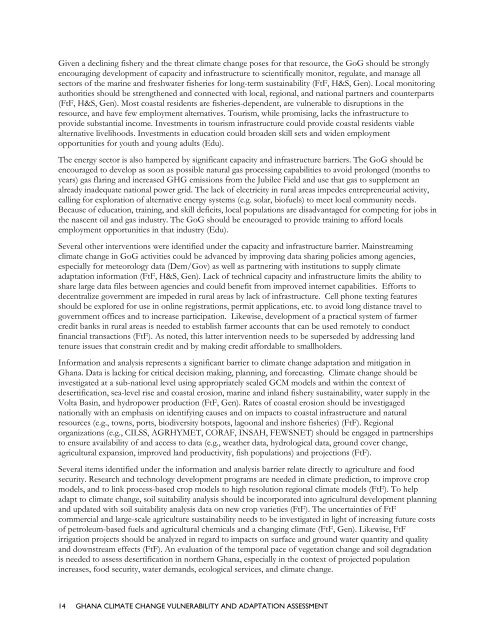ghana climate change vulnerability and adaptation assessment
ghana climate change vulnerability and adaptation assessment
ghana climate change vulnerability and adaptation assessment
- No tags were found...
Create successful ePaper yourself
Turn your PDF publications into a flip-book with our unique Google optimized e-Paper software.
Given a declining fishery <strong>and</strong> the threat <strong>climate</strong> <strong>change</strong> poses for that resource, the GoG should be stronglyencouraging development of capacity <strong>and</strong> infrastructure to scientifically monitor, regulate, <strong>and</strong> manage allsectors of the marine <strong>and</strong> freshwater fisheries for long-term sustainability (FtF, H&S, Gen). Local monitoringauthorities should be strengthened <strong>and</strong> connected with local, regional, <strong>and</strong> national partners <strong>and</strong> counterparts(FtF, H&S, Gen). Most coastal residents are fisheries-dependent, are vulnerable to disruptions in theresource, <strong>and</strong> have few employment alternatives. Tourism, while promising, lacks the infrastructure toprovide substantial income. Investments in tourism infrastructure could provide coastal residents viablealternative livelihoods. Investments in education could broaden skill sets <strong>and</strong> widen employmentopportunities for youth <strong>and</strong> young adults (Edu).The energy sector is also hampered by significant capacity <strong>and</strong> infrastructure barriers. The GoG should beencouraged to develop as soon as possible natural gas processing capabilities to avoid prolonged (months toyears) gas flaring <strong>and</strong> increased GHG emissions from the Jubilee Field <strong>and</strong> use that gas to supplement analready inadequate national power grid. The lack of electricity in rural areas impedes entrepreneurial activity,calling for exploration of alternative energy systems (e.g. solar, biofuels) to meet local community needs.Because of education, training, <strong>and</strong> skill deficits, local populations are disadvantaged for competing for jobs inthe nascent oil <strong>and</strong> gas industry. The GoG should be encouraged to provide training to afford localsemployment opportunities in that industry (Edu).Several other interventions were identified under the capacity <strong>and</strong> infrastructure barrier. Mainstreaming<strong>climate</strong> <strong>change</strong> in GoG activities could be advanced by improving data sharing policies among agencies,especially for meteorology data (Dem/Gov) as well as partnering with institutions to supply <strong>climate</strong><strong>adaptation</strong> information (FtF, H&S, Gen). Lack of technical capacity <strong>and</strong> infrastructure limits the ability toshare large data files between agencies <strong>and</strong> could benefit from improved internet capabilities. Efforts todecentralize government are impeded in rural areas by lack of infrastructure. Cell phone texting featuresshould be explored for use in online registrations, permit applications, etc. to avoid long distance travel togovernment offices <strong>and</strong> to increase participation. Likewise, development of a practical system of farmercredit banks in rural areas is needed to establish farmer accounts that can be used remotely to conductfinancial transactions (FtF). As noted, this latter intervention needs to be superseded by addressing l<strong>and</strong>tenure issues that constrain credit <strong>and</strong> by making credit affordable to smallholders.Information <strong>and</strong> analysis represents a significant barrier to <strong>climate</strong> <strong>change</strong> <strong>adaptation</strong> <strong>and</strong> mitigation inGhana. Data is lacking for critical decision making, planning, <strong>and</strong> forecasting. Climate <strong>change</strong> should beinvestigated at a sub-national level using appropriately scaled GCM models <strong>and</strong> within the context ofdesertification, sea-level rise <strong>and</strong> coastal erosion, marine <strong>and</strong> inl<strong>and</strong> fishery sustainability, water supply in theVolta Basin, <strong>and</strong> hydropower production (FtF, Gen). Rates of coastal erosion should be investigagednationally with an emphasis on identifying causes <strong>and</strong> on impacts to coastal infrastructure <strong>and</strong> naturalresources (e.g., towns, ports, biodiversity hotspots, lagoonal <strong>and</strong> inshore fisheries) (FtF). Regionalorganizations (e.g., CILSS, AGRHYMET, CORAF, INSAH, FEWSNET) should be engaged in partnershipsto ensure availability of <strong>and</strong> access to data (e.g., weather data, hydrological data, ground cover <strong>change</strong>,agricultural expansion, improved l<strong>and</strong> productivity, fish populations) <strong>and</strong> projections (FtF).Several items identified under the information <strong>and</strong> analysis barrier relate directly to agriculture <strong>and</strong> foodsecurity. Research <strong>and</strong> technology development programs are needed in <strong>climate</strong> prediction, to improve cropmodels, <strong>and</strong> to link process-based crop models to high resolution regional <strong>climate</strong> models (FtF). To helpadapt to <strong>climate</strong> <strong>change</strong>, soil suitability analysis should be incorporated into agricultural development planning<strong>and</strong> updated with soil suitability analysis data on new crop varieties (FtF). The uncertainties of FtFcommercial <strong>and</strong> large-scale agriculture sustainability needs to be investigated in light of increasing future costsof petroleum-based fuels <strong>and</strong> agricultural chemicals <strong>and</strong> a changing <strong>climate</strong> (FtF, Gen). Likewise, FtFirrigation projects should be analyzed in regard to impacts on surface <strong>and</strong> ground water quantity <strong>and</strong> quality<strong>and</strong> downstream effects (FtF). An evaluation of the temporal pace of vegetation <strong>change</strong> <strong>and</strong> soil degradationis needed to assess desertification in northern Ghana, especially in the context of projected populationincreases, food security, water dem<strong>and</strong>s, ecological services, <strong>and</strong> <strong>climate</strong> <strong>change</strong>.14 GHANA CLIMATE CHANGE VULNERABILITY AND ADAPTATION ASSESSMENT
















